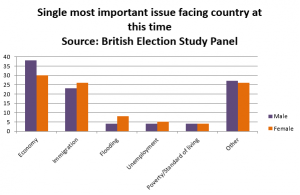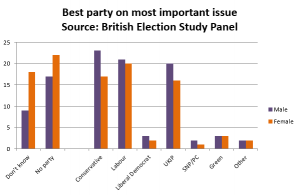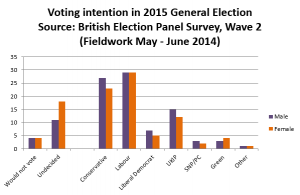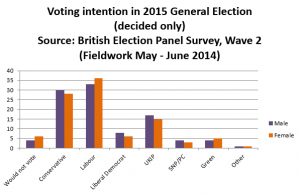
Paula Surridge, Senior Lecturer, School of Sociology, Politics and International Studies
When faced with a question about what anyone wants from the 2015 general election, the first port of call is the outstanding resource that is the 2015 British Election Internet Panel Study (BES). Beginning in February 2014 the study will follow a panel of the UK population on to the 2015 General Election and beyond. The data presented here were drawn from Wave 2 of the data with fieldwork conducted in May/June 2014. This wave of the data comprises 30,000 interviews allowing for detailed responses both by gender, and gender in combination with other social characteristics.
Most important issue
When considering what women might want, we first turn our attention to what respondents considered the most important issue facing the country. This question is routinely asked on opinion polls but the BES questionnaire takes a slightly different approach. The question asked here is entirely open ended (people are not given a predetermined list of important issues to choose from); in addition only one issue is recorded rather than up to 3 in most opinion polls.
 The chart shows that there are gender differences in terms of what people believe is the most important issue facing the country, though these are somewhat surprising. The most common response overall remains the economy, though this is chosen by a smaller proportion of women than men; with immigration in second place but this is chosen more frequently by women than by men. The chart shows only those issues which were mentioned by at least 4% of the population. It is important to note here the absence of issues often considered to be important to women such as the NHS and education.
The chart shows that there are gender differences in terms of what people believe is the most important issue facing the country, though these are somewhat surprising. The most common response overall remains the economy, though this is chosen by a smaller proportion of women than men; with immigration in second place but this is chosen more frequently by women than by men. The chart shows only those issues which were mentioned by at least 4% of the population. It is important to note here the absence of issues often considered to be important to women such as the NHS and education.
For both men and women there is a clear age gradient in this data; with the economy losing importance and immigration gaining it as we move to older age groups. There are also some very large differences, between genders, according to ethnicity. Among some groups the economy is mentioned more often by women than by men and unemployment is mentioned as the most important issue by 20% of Asian women and a similar proportion of Black men.
There are also important differences within educational groups; among women with no qualifications 43% gave immigration as the most important issue.
Best party on most important issue
For the most important issue to have electoral consequences voters must have a clear idea who they feel is best able to tackle the issue in the way they would like. The BES data ask people to identify which party they think is the best at handling the issue they have identified as the most important.
 There are large proportions of the population who either don’t know which party is best or who feel that no party is best on their most important issue; 1 in 4 men and 2 in 5 women have no clear idea which party is best on the issue most important to them. This suggests both opportunities and dangers for the parties. There is clearly significant potential here for parties to convince voters they are the best to handle the issues that matter; however if voters remain unconvinced there may be serious consequences for turnout.
There are large proportions of the population who either don’t know which party is best or who feel that no party is best on their most important issue; 1 in 4 men and 2 in 5 women have no clear idea which party is best on the issue most important to them. This suggests both opportunities and dangers for the parties. There is clearly significant potential here for parties to convince voters they are the best to handle the issues that matter; however if voters remain unconvinced there may be serious consequences for turnout.
Voting intention
This lack of certainty about which party is able to deliver on the important issues is reflected in voting intentions; with 15% of men and 22% of women either undecided on who to vote for or intending not to vote. In an election where polls are predicting less than 3% difference between the parties, convincing these undecided or ‘turned off’ voters could be critical.
 The differences in proportions which are undecided makes it difficult to draw direct comparisons between men and women on party lines. However, if we exclude those who have not yet decided how to vote we can see some gender differences in vote intentions.
The differences in proportions which are undecided makes it difficult to draw direct comparisons between men and women on party lines. However, if we exclude those who have not yet decided how to vote we can see some gender differences in vote intentions.
The gap between different party preferences is greater for females (28% Conservative, 37% Labour) than among males (30% Conservative, 33% Labour). There is also a smaller gender gap in the intention to vote UKIP than might have been anticipated given the perceived ‘women problem’ for the party. These patterns are even more marked when we consider gender differences among those in relatively advantaged social locations. For example, amongst women with a degree Labour have a 12% lead over the Conservatives, while for degree-educated men the Conservatives have a 1% lead over Labour.
 What do women want from the 2015 general election?
What do women want from the 2015 general election?
The answer to the question ‘what do women want from the 2015 general elections?’ is broadly the same as men in similar social positions. The main concerns are the economy and immigration. However, women are much less certain which party is likely to deliver what they want. Whilst large proportions of female voters are open to persuasion by the political parties it is wise to be cautious about talking about a ‘female vote’, there is as much variation in voting intentions among different groups of women as there is among different groups of men.
For further detail on the data behind this blog post please contact Paula Surridge P.Surridge@bristol.ac.uk
